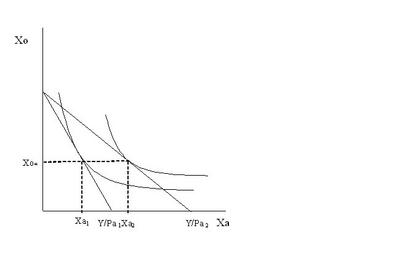all this is rusty, but i miss my econ courses cause im on coop in accounting right now so here it goes:
1. yeah you can go with oligopoly for sure, however if you want to work out a micro model for it I would honestly argue for perfect competition, which would be fairly easy seeing as the demand elasticity is so high. I would say that because so many more low priced skis are sold than those that are high priced, ski companies actually end up being price takers in the respective ski segments. Especially with the evolution of boutiqe manufacturers because the product is virtually undifferentiated and none of them have the ability to actually diverge from the market they end up taking the market norm as given for price
since my argument is for perfect competition the competition would be high
2. if you're doing micro and you are looking at the market impact you have to look at the changes in the market impact on the macro conditions and follow that to the price changes before you will see the impact on individual consumer decisions at the micro level
on the macro, depending on the market change/shift (whether it be interest rates, consumer confidence, business confidence, demand, supply etc.) there will be some final impact on price, if you look up the flow charts you can see the chain of events that cause the eventual change in price
here is what i can come up with for that, please note that all changes in the exogenous variables relate only to the ski industry, so if CC increases it'll be just for ski products, if G increases its just the government spending on the ski industry, please assume little to no spilloff to other sectors:
when you say market conitions you can look at government spending (g), taxes (t), consumer conf (CC) or biz conf (BC).
Im only gonna do this one way (reverse it if ya wanna see the opposite): G up or T down or CC up or BC up -->demand up--> demand>supply --> inventory down, new orders up --> production up, employment down --> real gdp goes up
Since output (gdp) is up the real money demand goes up --> real money demand > real money supply --> excess demand --> people sell bonds to increase cash flow --> the supply of bonds increases and price drops --> interest rates increase
because we are living in the real world we then have to look at the foreign exchange component (we assume flexible rates)
interest rate increases --> supply of foreign currency increases and demand for foreign currency decreases --> native currency appreciates (increased purchasing power, but this is a spillover to all industries)
the end result is increased aggregate demand which leads to higher prices, so we turn to the micro effect on an individual consumer:
the increased price for skis will lead to the ability for consumers with a fixed short run income to be able to buy fewer skis, therefore their optimal basket of goods (other goods vs skis) will change (all else the same).
im gonna use this graph to explain what happens:
where xa is skis and xo is all other goods, we start off on y/Pa2, and when price rises the line shifts to y/pa1. There is a decrease in demand for skis from xa2 to xa1.
The substitution effect is (draw a line parellell to y/pa1, but tangent to the rightmost indifference curve) and where that from x2 to whereever that x value is would be your substitution effect, then from said x value to x1 would be your income effect
hope this helps, gotta love econ









